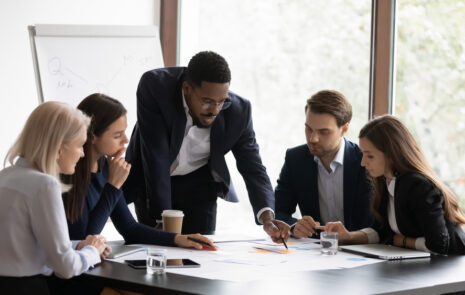
What Is A Message Map?
A Message Map is a simple, visual tool to help you tell your story better.

Thousands of people have learned to tell their stories better with message mapping.
You have a story. Your competitors have a story. Your brand wins when you tell your story better than your competitors by using a Message Map.
A Message Map simplifies and streamlines your company or brand story by putting it all on one page.
Message Maps help you become an even better storyteller as you:
- See what to say.
- Say what you mean.
- Keep your message clear, concise, and consistent.
That’s what it takes to tell a compelling story that breaks through to your audiences. With Message Maps, you can tell your story in only 7 seconds or 23 words — the length of an average sound bite in news media.
Companies such as AT&T, Kearney, The Home Depot, Intel, and EXL Service use Message Maps to frame key messages for marketing campaigns and other communications.
So do government agencies such as Chicago Metropolitan Agency for Planning (CMAP) and Chabot-Las Positas Community College. Nonprofit organizations such as Backbones and the Chicago Region Trees Initiative also use Message Maps.
With a Message Map, you’re always ready to communicate
With a Message Map in hand, you’re always ready when a journalist, blogger, or podcaster calls — because you know exactly what to say. It’s easier for executives and spokespersons to stay on message, even when you have to manage crisis communications.
My late friend Tripp Frohlichstein and I co-created Message Maps in the 1980s, originally to coach executives and spokespersons on how to deliver the right message through news media interviews.
Soon, we found that better messaging was needed in marketing campaigns, public relations, employee communications, investor relations, annual reports, trade shows, speeches, presentations, and more. The right messaging, created in advance, helps organizations be better prepared for crisis communications.
We saw that many organizations needed help to achieve message alignment, getting everyone in the choir to sing from the same songbook. Over the decades, we trained and coached thousands of executives, marketers, and communicators on how to co-create and use Message Maps.
With your Message Map in front of you, you are always ready to deliver a message that communicates clear benefits to each audience segment. Consistent messaging means your brand gains more traction faster, compared with your competitors.
The magic of a Message Map: it answers your target audience’s eternal question: what’s in it for me (WIIFM)?
There’s one thing that people always want to know upfront: what can you do for them? With your Message Map, you clearly articulate what your target audience needs – a good answer to their question WIIFM?
The better you understand the audience you’re talking to — informed by your buyer personas and audience segments — the easier it is to tell people what’s in it for them.
By design, a Message Map springs from one main message we call the heart of your message (formerly known as home base). The heart of your message is the one point to emphasize throughout all your communications, the one benefit you want people to know clearly – what’s in it for them?

Your message gets through, even to highly impatient people
These days, each person, each buyer persona, and every audience segment is highly impatient. People will give you only a few seconds of attention. They want you to cut to the chase by making the benefit clear.
Your Message Map helps you get the right conversation started by communicating one simple core message that is relevant to each person and each audience segment — the heart of your message.
Having only one message is crucial.
As Seth Godin says, “If you try to say three things, we will hear nothing. Because most of the time, we’re hardly listening.”
Multiple messages don’t stand a chance with people – they’re just too confusing, finds neuroscientist Dr. Carmen Simon. Confused buyers don’t write checks.
A Kantar Millward Brown study shows that, by focusing on delivering one core message, you can effectively reach 100% of your audience.
But if you try to send two messages, you lose a third of your target audience. That’s why you need one heart for your message … and why everyone in your company should be prepared to share the heart of your message.
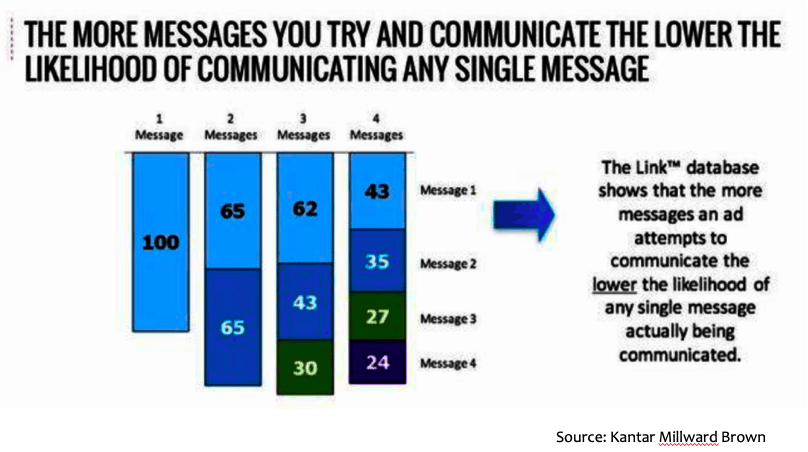
So what does your message need to accomplish in the first 7 seconds?
It needs to answer the audience’s question, What’s in it for me?, in the heart of your message, leading with the benefit or benefits your audience stands to gain. Once people know what’s in it for them, they seek reasons to believe you. Then give people 3 reasons to believe the heart of your message, which we call positive points.
Here’s the anatomy of a 7-second Message Map:

It will take time and repetition for people to learn, remember and believe the heart of your message.
Make your customer the hero. Your company or brand is the guide that enables the hero to succeed. Always focus on the benefits the hero-customer will gain from your brand’s guidance.
As you repeat the heart of your message, feel free to keep it fresh with variations. Don’t parrot it word for word like an overtrained politician.
As you deliver your main message consistently over time, you give your message time to sink in with each person in your audience. Your messaging gains credibility over time. Why?
Because consistent messaging earns a special place in human brains, in a person’s place cells – where brains store information that does not change.
Place cells store memories such as where your home is and other unchanging facts. What’s important about place cells is that they never run out of capacity.
Other areas of the brain quickly dispose of most short-term memories, which is why people forget 90% or more of what they learn.
Here’s the key: people can act only on what they remember — which is why the heart of your message must appear to stay absolutely consistent over time. Changeable messages, whether from fair-weather politicians or credible authorities, just don’t stick the same way in the minds and hearts of an audience.
The heart of your message needs 3 positive points to support it.
Three is a magic number because it’s the minimum number of points that enables humans to recognize patterns.
But two supporting points are not enough; they may be a sheer coincidence.
Four positive points are ok if you really need that many — but four is the absolute limit. Why? Because more than four points turn into clutter – too much information (TMI) for any person to absorb.
A Message Map frames your message to make it the right size and shape for your communications with all audience segments. It helps you deliver one main idea consistently, with 3 or 4 supporting points that offer reasons to believe.
As your Message Map scales up from 7 seconds to 2 minutes, you need to find 3 supporting points for each positive point, called proof points.
Good proof points put you in absolute command of all the facts and figures. Most brands’ key differentiation turns up in their proof points.
Then, search for 3 supporting points, which we call examples, that support each of your proof points.
The structure of a Message Map is a fractal, which means that 3 points support each higher-level point all the way up to the heart of your message.
With a Message Map, you’ll never forget the 3 points you wanted to make (as Rick Perry did in his career-limiting presidential debate).
Message Maps become a single source of truth for your brand
As you capture your story on a Message Map, you create a single source of truth for the brand and the whole company. You enable everyone to speak the same language, tell the same story, and stay on message — a feat that very few marketers, companies or brands achieve.
Your company won’t be like most competitors, where employees feel like they’re working in a Tower of Babel. People in each department speak a different language and tell different stories about the company. Those companies’ unaligned messages struggle to win anyone’s attention.
Most importantly, your Message Map helps you tell your story in a way that wins support from all the people who have a stake in your business. That’s because your stakeholders in each audience segment understand the answer to what’s in it for me.
A Message Map puts you in command of your story. It gives you an easy-to-tell storyline that proactively answers the questions on the minds and in the hearts of your customers, employees, investors, and influencers.
By understanding who your audience segments are, anticipating the questions people will ask, and getting out in front by telling your story proactively, you’re in the best position to tell your story well.
7-Second Message Map
Your 7-second Message Map prepares you to deliver that first tasty bit of information that hooks your audience and leaves them hungry for more. In 7 seconds, you can deliver your brand’s elevator speech, sound bite, headline, social media post, or email subject line.
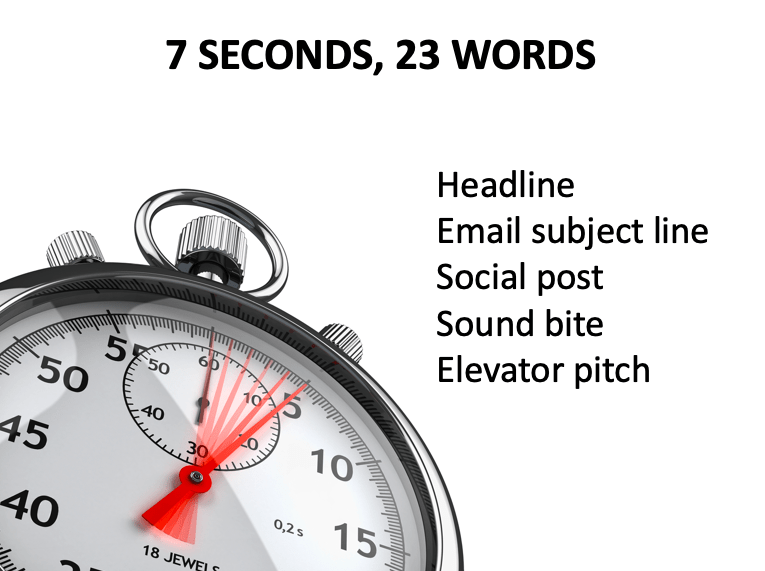
Why do you need a Message Map?
- Because you need to hook people’s attention quickly by answering their question, “What’s in it for me?” (WIIFM?)
- Because your brand needs one consistent message to address all your audiences — customers, employees, investors, and influencers.
- Because you want to be quoted accurately in news and social media by telling your story in short, quotable, memorable sound bites.
A Message Map hooks people quickly and then scales up gracefully.
Once you hook your audiences’ initial interest in the first 7 seconds, you start to overcome their impatience. You gain their permission to expand your story to 2 minutes, 20 minutes, or more.
Scale your message up to 2 minutes by adding 3 proof points to each positive point. Proof points answer the question, What’s the proof?
Here’s the anatomy of a 2-minute Message Map:

Now you have a 2-minute message that fits short-form content such as web pages, blogs, news releases, videos, and more. Mapping your message gives you a visual aid that keeps all your communications on message.
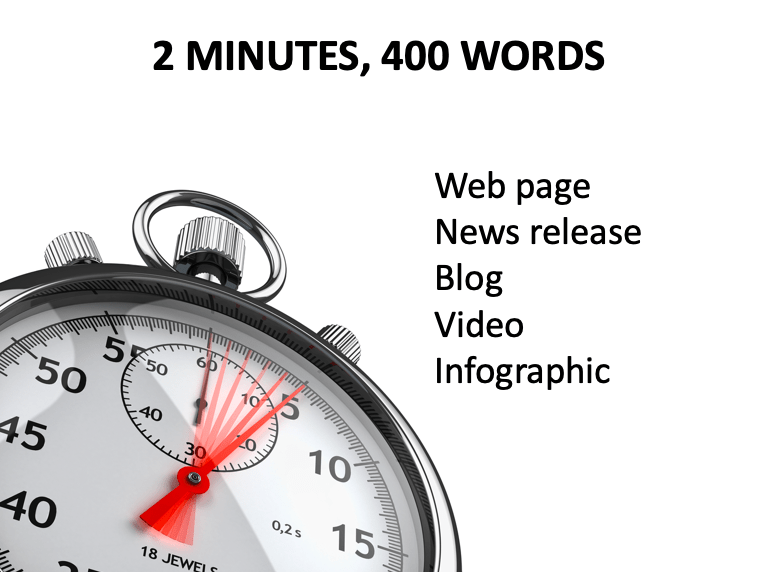
Message Maps make your business message expandable, like an accordion. Your message will fit any length, time, or space, in any medium — digital, print, and live — with every audience segment.
A 20-minute Message Maps adds 3 examples to each proof point.
For technical and complex subjects, it’s essential to create a 20-minute Message Map. Why? Because everyone needs help to keep a complex story straight.
Many B2B marketers create a number of 20-minute Message Maps to explain their company, brand, products, technology, and specific topics such as diversity and sustainability.
Here’s the anatomy of a 20-minute Message Map:

Build a 20-minute Message Map to frame long-form content such as speeches and presentations, white papers, e-books, reports, and articles.
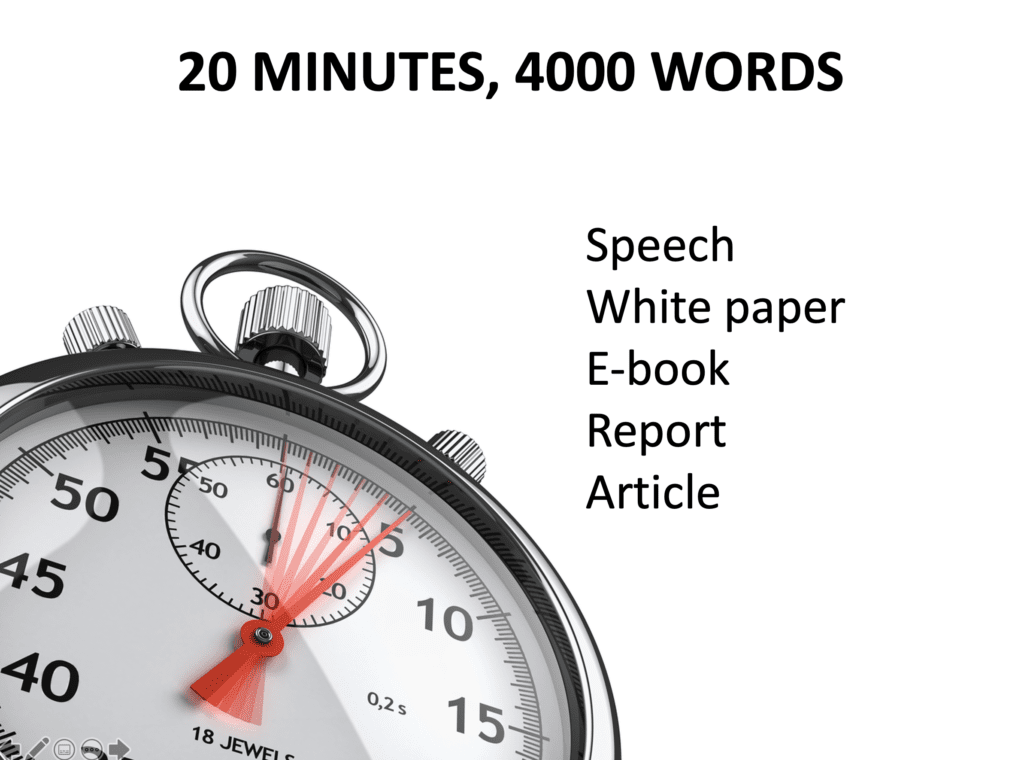
By co-creating a Message Map with your executive team, sales, and subject-matter experts in the same room, you gain instant buy-in for your message from the top. That’s why I encourage you to build a big tent to co-create your company message.

When you co-create your message, it enjoys support from your leadership team, which makes it easier to get communications, marketing, public relations and investor relations jobs done successfully.
Message Maps help employees tell your brand’s story.
With a Message Map, you can bring employees aboard as brand ambassadors. You train them with one simple consistent message that enables them to tell customers what your brand stands for.
Your competitors’ employees probably cannot tell their company’s story. In fact, most employees in most companies can’t tell their brand’s story, a Gallup study found.
“Two-thirds of employees have direct customer contact at work, but they still don’t seem to know what their customers care about.” When your employees deliver relevant messages that address real customers’ concerns, your brand becomes more and more valuable.
Your Message Map not only helps everyone get on the same page, but it also saves you time by speeding up all your communications. In particular, message mapping simplifies and streamlines review processes.
Why? Because most of the reviewers have bought into your message upfront. As a result, review becomes less of a nightmare — so you can focus on getting your job done instead of managing complex review processes.
Your Message Map enables you to:
- Frame one consistent story for all your communications.
- Rapidly, and accurately answer questions from customers, employees, investors, news media, analysts, and influencers.
- Get people interested in your business message by tying it into today’s news (known as newsjacking).
- Stay on message by keeping your message completely consistent, with all media and audience segments.
Consistency is the key to earning credibility in the eyes of your audience. A Message Map helps you keep absolutely consistent in a time when “changing your story” can smell bad.
For more information on message maps, subscribe to our blog.
Once your Message Map is ready to go, it’s easy to share your message through digital, print, and live media.
Make sure your consistent message appears on your website, social media, news releases, brochures, emails, and in meetings, trade shows, and events.
Remember, the number one people leave B2B websites is the lack of a message.
Now that you have your Message Map all on one page, it becomes a tool for everyone who talks with customers, employees, investors, and influencers such as analysts, bloggers, and news media.
With training and practice, you can get your whole choir — everyone in your company — to sing from the same Message Map. Your company becomes a place where everyone tells your customers, employees, investors, and influencers one consistent, memorable story.
Absolute consistency is how your story will gain the power and momentum to earn its unforgettable spot in people’s minds.
What is a Message Map?
What could you accomplish if your brand and company messages became more powerful than they’ve ever been before?
That’s what you get with a Message Map. For a free Message Map template to create your own message, email us at george@crystalclearcomms.com or ariana@crystalclearcomms.com.
If you need help creating a Message Map, we facilitate messaging co-creation sessions, online and live.
We train your media spokespersons to stay on message, help presenters present even more effectively, and help you train employee brand ambassadors to deliver your message to customers.
Ready to create your own Message Map? Contact us today.
For more information on Message Maps, subscribe to our blog.
Related Posts
Are you earning brand loyalty?
I had the luxury of spending last month in Nafplio, Greece, where I was embraced by the locals. Restaurateurs, shopkeepers, and even the gentleman...
“How to use content marketing to capture our most challenging audience?”
Content marketing to capture our most challenging audience is a key concern among content marketers. A marketer from Gogo Air asked, “How to use...
Content marketing in tough times: Stay true to your brand voice
As an expert who coaches clients on content marketing, I’m always curious about content marketing from brands I respect. Lately I’ve been surprised to...
How to change boring content into brilliant content
When content seems boring, often it’s because the content is too abstract. To get readers to sit up straight in their chairs, spice up...



